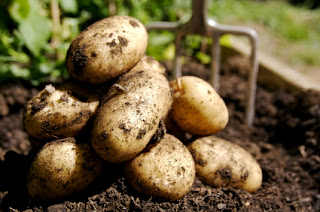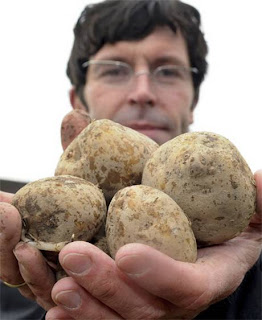Hello everyone, welcome to my blog! This is my first blog post so thank you very much for reading! Today I'm going to talk about one type of genetically modified potatoes—Amflora potatoes.
First of all, let’s talk about genetically modified foods, or GM foods. They are foods that have altered genetic materials using genetic engineering techniques. GM foods were initially introduced into North America in 1994 and into Europe in 1996. Now GM products are quite common in our everyday lives, such as golden rice, GM tomatoes, super sweet sugar cane, and GM potatoes.
Otter, A. (2009, October 23). SA government rejects GM potatoes. Treevolution. Retrieved February 20, 2011, from www.treevolution.co.za/2009/10/sa-government-rejects-gm-potatoes/
Many researchers around the world had made different types of GM potatoes: they can contain high proteins, have resistance of pests and diseases, or are beetles-free. However, there are no genetic modified potatoes in North America currently, because people are afraid of potential health problems.
Conversely, Amflora potato is very different from those types of GM foods. It is not created as a food for human; it is used for starch industry.
In Europe, 25% of potatoes are actually eaten by people, 50% are being fed by livestock, and the remaining 25% are used for the production of alcohol and starch.
Every year, starch companies need to spend tons of money to separate two types of starches in potatoes—80% is Amylopectin, used for paper-making process, and the other 20% is Amylose, used mainly in the production of foils and films. To reduce the cost for running expensive machines and reduce the tole on the environment, German company BASF SE created Amflora potatoes. Its name combines the Greek word for starch, “amylon”, and the Latin word for flower, “flora”.
Every year, starch companies need to spend tons of money to separate two types of starches in potatoes—80% is Amylopectin, used for paper-making process, and the other 20% is Amylose, used mainly in the production of foils and films. To reduce the cost for running expensive machines and reduce the tole on the environment, German company BASF SE created Amflora potatoes. Its name combines the Greek word for starch, “amylon”, and the Latin word for flower, “flora”.
But how is Amflora potato created? Using molecular biology, scientists had deactivated the gene of regular potatoes that produce unwanted amylose, so only amylopectin will be produced by the Amflora potatoes. When several GM potato lines have been created, nptll gene—the gene in the potato that is against antibiotics kanamycin and neomycin—will let the modification take up the whole potato. People were concerned that nptll gene will accelerate manifestation of antibiotic resistance in pathogenic bacteria, but the result turned out well.
Hickman, M. (2010, March 4). Fury as EU approves GM potato - Green Living, Environment - The Independent. The Independent | News | UK
BASF SE Company in Germany started this project in the 90’s. The request for authorization was submitted by EFSA (European Food Safety Authority) in August, 1996; after about 13 years later, European Commission (EC) approved Amflora potatoes to grow, use for industry, feed stocks, and use the pulp as biofuel in European Union Market in March 2010. Amflora potato is the first approved GM crop by EC in 12 years. By the way, Sweden was the first country to grow Amflora potatoes.
However, Europeans didn’t totally accept Amflora potatoes. People protested on the streets, and many countries in Europe are still testing its functions. Europeans are concerned if some potential problems can only be found after eating for some decades. The most significant risk is GM foods may change the human genes. Also, GM foods can change the natural environment, harm the diversity of species, lower the natural resistance of pests and diseases, and create bad effect from cross-pollination of normal organism and GMO. Although BASF SE said there is no environmental effect, but people won’t believe it. Since BASF SE will benefit the most, what if it lies to people? After all, problems won’t be shown after several years; at that point BASF SE has already made lots of money, and they can claim that they dismiss some reactions and get rid of the responsibilities. As for the starch companies, they will also benefit a lot, because they can save a huge bulk of money from separating two types of starch.
Here I made a chart of pros and cons of Amflora so people can read some points easily.
Advantages | Disadvantages |
-reduce the cost of making starch
-create money
-environmentally friendly, no more harmful chemicals are used
-benefit for manufacturing paper, glue, textile
-create jobs
-high yield
| -long term health concerns
-may cause antibiotic resistance
- may cause gene transfer between organisms
-cross pollination of natural potatoes and Amflora will make a mixture
-change the natural environment
-harm the diversity of species
-against some religion—things should all be made by god
|
Personally, I don’t accept GM foods, because they have too many potential problems. Although Amflora potatoes are not used as human food, they will be eaten by stocks, and eventually the problem will show in humans. Nature is very powerful; if some species can’t follow the steps of other species, the nature will let them evolve or they will disappear. Things have their own reasons to exist on earth, so anything that’s made unnaturally will mess up the normal balance, the food chain, and the human’s body. Sure these foods can create huge money, but remember people shouldn’t throw away their conscience.
Another thing is that I'm happy to see GM foods being labeled by law in Europe, but I'm not happy that in Canada and United States, foods don’t need to be labeled if they are genetically modified. I hope Health Canada can change this. Canadians have the right to know what they eat everyday.
Sources:


